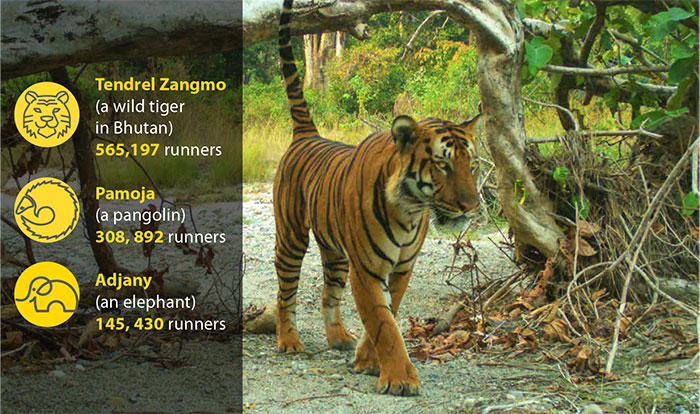Choki Wangmo
Within 10 days, more than one million people across the world participated in the digital running challenge—Run Wild—that lets users run with Tendrel Zangmo, a wild tiger in Bhutan being researched by the Bhutan Tiger Centre (BTC).
Tendrel Zangmo, a Royal Bengal Tiger, is a lactating mother with two cubs in the Royal Manas National Park.
The challenge also includes Adjany, an elephant and Pamoja, a pangolin.
Tendrel Zangmo had the highest number of competitors (565,197 runners), followed by Pamoja (308, 892), and Adjany (145, 430).
The campaign which ended earlier this month was aimed at giving a voice to one million species that are under threat of extinction at the UN General Assembly Biodiversity Summit. The summit, which ended on September 30, calls on heads of state to put forward ambitious actions to address biodiversity loss.
“We are one million runners in favour of a more sustainable planet where humans, animals, and everybody else on the web of life can thrive,” according to Runtastic, an Adidas running app used for the campaign.
In Bhutan, foresters, students, Bhutan run clubs and civil servants, among others, competed with Tendrel Zangmo.
There were 79 registered runners. A forester from Gelephu range, Dee Dorji ran the longest distance of 267.11km.
A forester who participated in the campaign said that within six days, he ran 50km. “To take up the challenge, one has to download the app and also read about the challenge so it informs the people about the cause, creates awareness amongst wider audience.”
Head of the BTC, Tshering Tempa (PhD), said that the predator-prey dynamic project with BTC, funded by Bhutan Foundation,provided information about Tendrel. The United Nations Environment Programme (UNEP) helped to get the platform on Adidas runtastic to tell the story of tigers and Bhutan’s conservation efforts.
The participants were encouraged by BTC to outrun Tendrel Zangmo’s daily distance, whose running statistics is featured in the app.
UNEP and Adidas Runtastic in collaboration with Internet Elephants and other conservation organisations challenged the runners to outrun iconic endangered wild animals in a bid to rally support for biodiversity protection worldwide.
One million runners symbolised one million animal and plant species threatened with extinction, as reported by the Intergovernmental Science-Policy Platform on Biodiversity and Ecosystem Services (IPBES), stated the press release from UNEP.
The first Run Wild challenge last year saw 500,000 participants try to match the distance covered over 12 days by the tracked wild snow leopard called Uuliin in Mongolia.
IPBES found that 75 percent of the land-based environment and about 66 percent of the marine environment have been significantly altered by human activities such as deforestation and land use change for agriculture, pollution and unsustainable consumption, contributing to species’ extinction.
Scientists say that there is only a short window of time to reverse the current trajectory that is inflicting wholesale human-induced environmental degradation on the planet and its web of life.


